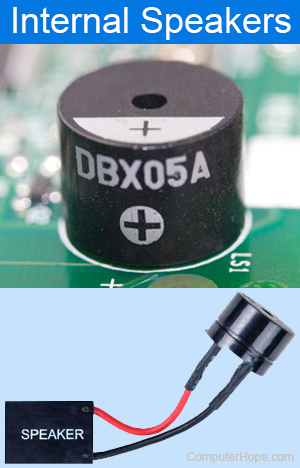How to disable or enable the computer internal speaker

The answer to this question depends on the computer's motherboard, its configuration, and the installed software.
These steps are for enabling the internal speaker that makes basic noises. If you have problems with playing music or sound in videos, see: Why do my computer speakers not work?
Disabling the internal speaker
Software
If you're running Microsoft Windows, you can disable the internal speaker or PC speaker by following the steps below.
- Open the Device Manager
- In Device Manager, click View and select Show hidden devices. Once done, Non plug and play Drivers becomes visible in Device Manager.
- Expand Non plug and play Drivers by clicking the plus and double-click Beep.
If you do not see a Non plug and play Drivers section in the Device Manager, skip to the Motherboard jumper section below.
- In the Beep properties window, click the Driver tab.
- On the Driver tab, to temporarily disable this device, click the Stop button. To permanently disable this device, under the Startup type, select Disabled.
Motherboard jumper
If the steps above don't disable the internal speaker (i.e., there's no Non plug and play Drivers section), the internal speaker can be disabled by the motherboard jumpers. Many motherboard manufacturers have jumpers that, when jumped or not jumped, enable or disable the onboard speaker.
All motherboards are different. Refer to the motherboard's documentation to determine if your motherboard has such a jumper, and how it should be set.
Motherboard cable
Some motherboards do not have an onboard speaker and instead use a computer case speaker that can be removed to disable the speaker. Refer to the motherboard or computer's documentation to determine if your computer is set up this way.
Enabling the internal speaker
Software
If you are running Microsoft Windows, you can enable the internal speaker or PC speaker by following the steps below.
- Open the Device Manager
- In Device Manager, click View and select Show hidden devices. Once done, Non plug and play Drivers becomes visible in Device Manager.
- Expand Non plug and play Drivers by clicking the plus and double-click Beep.
If you do not see a Non plug and play Drivers section in the Device Manager, skip to the Motherboard jumper section below.
- In the Beep properties window, click the Driver tab.
- On the Driver tab, to temporarily enable this device, click the Start button. To permanently enable this device, under the Startup type, select System.
If the internal speaker does not work after enabling it through the Device Manager, the internal speaker may be defective and non-functional. In this case, usually, a motherboard replacement is merited, as it is difficult to replace the internal speaker on the motherboard.
Motherboard jumper
If the steps above don't disable the internal speaker (i.e., there's no Non plug and play Drivers section), the internal speaker can be disabled by the motherboard jumpers. Many motherboard manufacturers have jumpers that when jumped or not jumped enable or disable the onboard speaker.
All motherboards are different. Refer to the motherboard documentation to determine if your motherboard has such a jumper and what its setting should be.
If the internal speaker doesn't work after enabling it with a jumper, the internal speaker may be defective and non-functional. In this case, the motherboard would need to be replaced or repaired by a technician.
Motherboard cable
Some motherboards do not have an onboard speaker and instead use a computer case speaker that can be removed to disable the speaker. Refer to the motherboard or computer's documentation to determine if your computer is set up this way.
